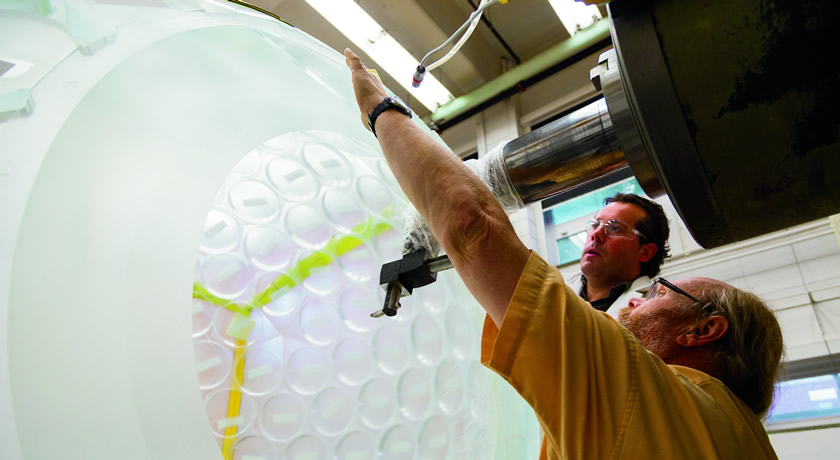
Professor Aksel Hallin and machinist Antonio Vinagreiro with the DEAP neutrino detection vessel at the University of Alberta.
This spring, scientists at SNOLAB will switch on a dark matter detector that was designed and built at the University of Alberta.
The detector, called DEAP-3600, is located in a nickel mine outside of Sudbury, Ontario. The facility is part of SNOLAB, laboratory operated by a multi-institutional partnership that includes the University of Alberta.
Dark matter is thought to make up about 27 per cent of the known universe. The nature of this dark matter and its explanation in terms of subatomic particles is a central question in physics today.DEAP-3600 is designed to look for the leading candidate, dark matter particles that are very weakly interacting and about the mass of a tin atom. Such subatomic particles would fill the outer reaches of the galaxy.
The detector will be filled with liquid argon, a substance with which such dark matter particles can interact. These particles are so small, they would pass through most material, including the human body. The particles fill the galaxy, and we calculate that there should be a few thousand in every cubic meter of space. They pass through us all the time at velocities of a few hundred kilometers per second.
There are actually several major components to the DEAP-3600 detector: an outer metal shell, the acrylic vessel that holds the liquid argon, the light guides that direct light into the central core of the detector, and the electronics needed to observe and record the behavior.
Professor Aksel Hallin, the Canada Research Chair for astroparticle physics, says many parts of DEAP-3600 were designed and/or made here at the University of Alberta. (The DEAP-3600 collaboration is led by Queen's University and includes the participation of Carleton and Laurentian universities.)
"We led the design of the acrylic vessel, then procured it and did all the machining of the vessel," says Hallin. "We developed the process of bonding the light guides to it and purchased the material for the light guides."
The light guides were manufactured at TRIUMF (Canada's national laboratory for particle and nuclear physics), of which the University of Alberta is a founding member. Hallin adds: "The electronic signal conditioning boards were designed and built at the University of Alberta and integrated with the system made at TRIUMF."
Most recently, Hallin's group designed and machined flow guides that will ensure the proper circulation of argon. "The simulations of the liquid argon flow guides were done here and were machined in the radon-free lab. "
Hallin says the work has to be done in a radon-free environment because radon decays quickly into radioactive elements that would interfere with the experiment's readings of neutrinos. This is especially problematic in the mines, where the bedrock has high levels of radon: "It decays into lead 210 (Pb^210), which has a 22-year half-life, and lead 210 (Pb^210) decays to radioactive polonium, which has a half-life of 140 days," says Hallin. "You can't just wait for it to go away." The group will transport the flow guides in a vacuum tank to protect it from radon radiation.
After the flow guides are installed, there will be more on-site testing. Members of Hallin's group - which includes undergrads, graduate students, and postdocs - will be at SNOLAB for the final preparations and the formal start of the experiment.
"We're hoping to be online in April," says Hallin. "We have to coat the inside of the vessel and start to calibrate it."
The research collaboration has created a book showing how DEAP-3600 has gone from being giant ball of acrylic to a cutting-edge dark matter detector.
Symmetry Magazine recently published a feature about the DEAP-3600 experiment.